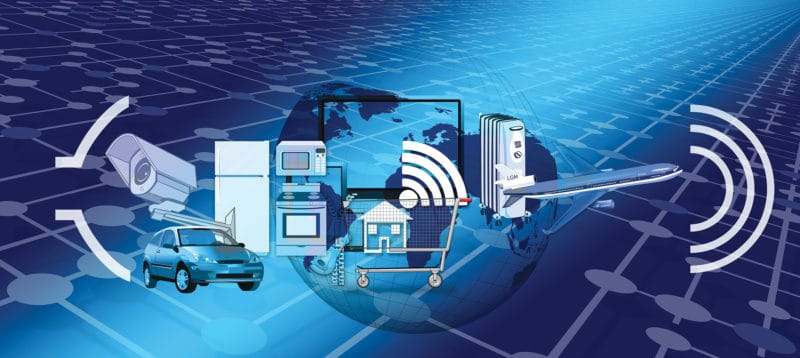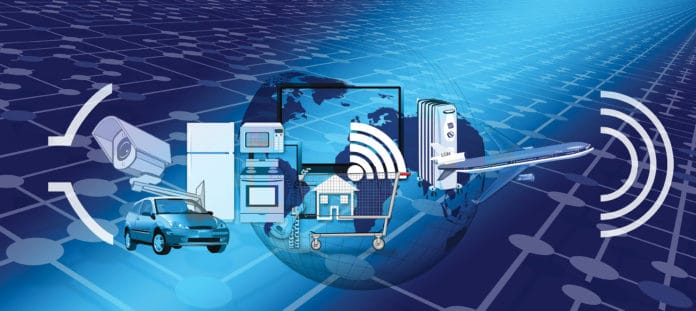This article is based on a talk by Rittu Sachdev, RF engineer, Texas Instruments, at India Electronics Week 2019 organised by EFY Group. She explains how communication standards that started off with non-IoT (Internet of Things) applications are now evolving to help the IoT.

The Internet of Things (IoT) thrives on communication standards, and these standards are evolving rapidly to support the IoT better. IoT applications range from home and building automation to smart cities, smart manufacturing, wearables, automotive and agriculture. Scope of the IoT is immense; however, depending on the use-case, IoT applications can pose different challenges for wireless communication standards.
Building a wireless communication standard for the IoT is hard with all the available communication standards. It is not easy to decide which one is best suited for a particular IoT application. There are standards spanning from personal area networks (PANs) and proximity sensors to wide-area networks (WANs) and low-powered wide-area networks (LPWANs) that are specifically meant for the IoT. And in between, there are also wireless LANs (WLANs). Different communication standards offer different specifications to help the IoT in different ways. These communication standards are evolving and enabling new and future IoT applications.
The IoT drives communication standards on both (opposite) ends. It needs low latency (fast response time) as well as low power. Some applications require high data rate and wide range. These are conflicting goals and are difficult for a single wireless standard to achieve. On top of this, there are other things to be resolved such as security, low cost, network capacity and reliability. This is the real challenge for wireless communication standards.
Evolving wireless standards in the IoT communication
Some wireless standards that are evolving to help the IoT are 802.11 for WLANs (802.11ax and 802.11ba that are coming up as new standards), Bluetooth 5, sub-1GHz and narrow-band IoT (NB-IoT), which is meant specifically for the IoT.
802.11ba is also called wake-up receiver. Usually, WLAN is used for applications that require very high data rate and where power is not a concern. But to enable the IoT, WLAN has to reduce its power consumption. The new standard of WLAN, 802.11ba, works with previous-generation Wi-Fi 5 or Wi-Fi 6 standard to help achieve low power.
Low power is usually achieved by keeping the wireless device in sleeping mode most of the time, but that increases latency, which makes response time of the system very slow. In many applications this is not possible because faster response time, data rate and low power are also needed.
The goal is to achieve both low power and low latency. This is achieved by low-power wake-up receiver (LPWUR). It works in conjunction with the normal WLAN transceiver (TRx). The basic function of wake-up receiver is to sniff the air for wake-up packets. Once it receives wake-up packets, it turns on the main transceiver.

One classic example of this is the video doorbell, which needs high data (because it is video); if it is battery-operated, power needs to be saved. A video doorbell needs to continuously sniff the air for online commands to operate the lock and that drains power. So, instead of keeping the main WLAN receiver on all the time (which is actually meant for high data rate), just for sniffing purpose, the wireless wake-up receiver can check for wake-up packets and then turn on the main WLAN receiver. This saves a considerable amount of power, which helps the IoT get high data rate, low latency as well as low power.
Main IoT enablers possible by 802.11ba are given below.
- Battery life can be increased by ten times because the wake-up receiver is a simple receiver. It is a sniffing radio and consumes less than ten per cent of the actual WLAN receiver power.
- The wake-up receiver can always be kept on. Thus, its response time can be in milliseconds.
- It can be always connected. As an example, let us take the case of sensors on the move, like the mobile application with sensors moving around. If there is a disconnection from the access point (AP), instead of keeping the WLAN receiver on to sniff to see whether one is within AP coverage, one can use the wake-up receiver to sniff for AP coverage. This again saves considerable power.
There are future advances possible for 802.11ba. The wake-up packet consists of a legacy field and a data field. Data field can be used to selectively turn on devices to have addresses for specific devices and those devices with the wake-up packet. Other uses of the data packet are as follows:
- Indoor location scan, which can be implemented using data packets from neighbouring access points (APs) to figure out one’s location.
- Roaming scan; when one moves out of AP coverage, WLAN receivers turn on a scan to check for new, available networks. This can be done on a wake-up receiver, which substantially reduces power consumption for the WLAN device.
Wi-Fi 6, also called 802.11ax, is the latest upgrade for WLAN. This is a substantial improvement over the previous standard, Wi-Fi 5 or 11ac. Wi-Fi 5 was mostly focussed on increasing data throughput in favourable conditions. Wi-Fi 6 tries to achieve the best possible average data output from WLAN. Though WLAN is capable of gigabits/sec kind of data rate, it is normally not possible. Data rate substantially drops when there are multiple connections to the same AP. Wi-Fi 6 is trying to address this issue.
There are two major changes between ac and ax, as given below.
- The technology has changed from orthogonal frequency-division multiplexing (OFDM) to orthogonal frequency division multiple access (OFDMA).
- Sub-carrier data spacing (frequencies that carry data symbols) has reduced from 312KHz to 78KHz. 78KHz means that there are data bins/carriers closely packed together.
Usually, WLAN channel is 20MHz long, which can pack four times more data carriers using lower sub-carrier spacing.
Symbol length and sub-carrier frequency are interlinked, which means if frequency reduces, symbol length increases.
The advantage of having a longer symbol length is that one is more immune to delays of signal reception. So, in case of multiple signal reflections, each reflection is slightly delayed. When that happens, the longer the symbol length, the more robust it is, without inter-symbol interference.
Longer symbol length helps achieve a bigger guard interval, which is 3.2 µs versus 0.8 µs. A bigger guard interval safeguards from multiple reflections and helps get more reliable data. This improves average throughput in dense environments when connections to AP increases.
Apart from these two major changes, speed has increased, which is the main purpose of WLAN. 256 QAM has gone up to 1024 QAM, which is almost a 25 per cent increase in data rate.
Data rates of 600Mbps can be obtained for a single spatial stream and 80MHz BW. WLAN6 allows for eight spatial uplink and downlink streams making multiple gigabits/sec data rates possible.
Sub-carrier spacing reduction enables packing more sub-carriers in 20MHz channel bandwidth
Wi-Fi 5 has 52 sub-carriers in 20MHz bandwidth. Whereas, Wi-Fi 6 packs 242 sub-carriers in the same 20MHz channel. These sub-carriers can be divided into nine parts called resource units. Minimum size for a resource unit is 26 sub-carriers and 2MHz bandwidth.
Wi-Fi 5 allocates minimum 20MHz bandwidth to a single user irrespective of the quantity of data packet. So, data-intensive video downloads and low-data activities like sending a text message both get the same allocation of bandwidth. This is a waste of precious spectrum resource.
With Wi-Fi 6, spectrum space can be more efficiently utilised with OFDMA technology, which allocates lower bandwidth (2MHz) to low-data-rate activities and high bandwidth to higher-data-rate applications. It also allows multiple low-data-rate activities from different users/devices to be served in the same channel at the same time, improving system efficiency.
11ax features that enable the IoT are as follows:
- OFDMA for both uplink as well as downlink. It offers more spectrum efficiency and more network capacity. More users can be served at one time.
- 8×8 multi-user MIMO uplink and downlink. It allows transmitting to eight users together for both transmission and reception.
- Long OFDM symbol duration.
- Power save modes with longer sleep intervals and scheduled wake-up times.
In terms of future IoT use-cases that 11ax enables, there are battery-operated devices for video surveillance, remote diagnostics, disaster management and so on. All these use-cases require low power, long range, low latency as well as good data rate.
There are augmented and virtual reality (AR and VR) kind of applications that Wi-Fi 6 enables in high data rate modes. Virtual training, virtual diagnostics, robotic surgery, AR tourism and others are some of the new applications that have become possible with Wi-Fi 6.
Bluetooth 5: the latest technology from Bluetooth
The previous generation, Bluetooth 4, had two sub-parts: classic and low energy. Classic was mostly used in headsets and sound buds. Low energy is used in wearables, fitness bands and similar applications.
Bluetooth 5 has new features that enable the IoT. Some of the features are given below.
- It gives 4x longer range for low data rates. This is enabled by adding more forward error correction to the data that is sent. For every bit of data that is sent, this mode sends two more error correction codes that improve the chances of detecting that bit, giving four times the range. But this is only for low data rates.
- Bluetooth 5 can achieve 2Mbps data rate. Faster data rate is achieved by doubling symbol rate. This helps with faster pairing, connection and download speed.
Earlier, Bluetooth 4 had 31 bytes for advertising, which is basically broadcast messages. This has now been increased eight times, thus helping achieve richer advertising content.
Various applications of Bluetooth 5 include health and fitness (heart rate monitors, smart bands), wireless audio (soundbars, speakers, headsets), retail (location-based ads) and so on. Most of these are like Bluetooth 4, but their specifications have improved, with lower power and better range.
Wireless standards that are specifically meant for the IoT
Sub-1GHz is specifically meant for IoT applications. It gives very long range (as band is from 750MHz to 950MHz), possibly up to 20km distance. It can run for multiple years on a single coin battery. This robust technology uses frequency hopping and is less susceptible to interference, and avoids the crowded 2.4GHz space.
Its applications include streetlight controls, e-meters, smoke detectors, toll road tax systems, irrigation systems and the like.
NB-IoT is the latest LTE standard. It is the lowest data rate LTE version. In LTE, there is the high-performance mode that offers up to 1Gbit/s kind of data rates. This is where 5G is going to come. At the other end of the spectrum, it has low cost, power and throughput. The range is 20km with data rate of 250Kbps. Use-cases are similar to sub-1GHz.
Choosing the right wireless standard
Depending on the use-case, the communication technology should be selected. Except for NB-IoT, which is subscription-based, all others are licence-free. While NB-IoT and sub-1GHz offer a good range, Wi-Fi is the best choice for speed. Bluetooth, sub-1GHz and NB-IoT give similar battery life.
As per a Digi-Key report, cost is the highest for NB-IoT at ₹ 1000. Cost for both Wi-Fi and Bluetooth is ₹ 300, while that of sub-1GHz is higher at ₹ 350. These are module costs, including antenna.
Rittu Sachdev is RF engineer at Texas Instruments










